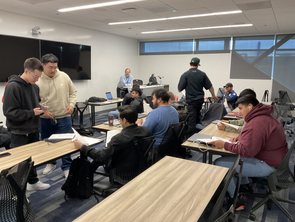Introduction
In the ever-evolving landscape of business, the function of education-- particularly entrepreneurship education-- has never ever been more crucial. The professors who lead these programs are not just teachers; they are mentors, innovators, and drivers for modification. Leading by Example: How Terrific Professors Forming Future Entrepreneurs encapsulates the essence of what it indicates to teach entrepreneurship successfully. This short article will check out the characteristics, techniques, and philosophies that set fantastic entrepreneurship teachers apart from their peers, eventually shaping the next generation of entrepreneurs.

What Sets Terrific Entrepreneurship Professors Apart: The Science and Soul Behind Teaching Mindset
Entrepreneurship is not simply about starting a business; it's about cultivating a state of mind. Fantastic professors understand this fundamental truth and focus on teaching students how to think like business owners. But what precisely sets them apart?
The Value of State of mind in Entrepreneurship
- Growth vs. Repaired Mindset: Professors emphasize the value of having a development state of mind, motivating students to view challenges as chances for learning. Innovation Orientation: They promote an environment that values creativity and development, encouraging students to think outside the box.
Empathy and Connection
- Building Relationships: Great professors concentrate on structure strong relationships with their trainees, comprehending their backgrounds, goals, and fears. Inclusive Learning Environments: They produce inclusive spaces where varied ideas can flourish.
Real-World Experience
- Industry Connections: Lots of effective teachers have extensive networks in the market that they utilize for trainee internships and job placements. Real-Life Case Studies: By incorporating real-world case studies into their curriculum, they assist trainees comprehend intricate concepts through practical examples.
How to Teach Grit, Versatility, and Chance Acknowledgment-- And Really Make It Stick
Teaching entrepreneurial abilities surpasses theory; it needs useful application. Here's how excellent professors instill grit, flexibility, and chance acknowledgment in their students.
Instilling Grit Through Challenge-Based Learning
- Setting High Standards: Professors push trainees out of their comfort zones with extensive projects that simulate real-world challenges. Encouraging Resilience: They teach students how to bounce back from failures by sharing individual stories of struggle and success.
Fostering Flexibility in Dynamic Environments
- Simulations and Role Plays: Lots of classes involve simulations where students need to adjust quickly to altering scenarios. Feedback Loops: Continuous feedback helps trainees gain from errors in real-time.
Opportunity Recognition Exercises
- Market Analysis Projects: Trainees are charged with identifying spaces in the market through hands-on projects. Networking Opportunities: Professors often bring guest speakers who share insights on acknowledging opportunities in numerous industries.
Real-World Learning, Real Outcomes: Classroom Methods That Introduce Ventures and Modification Lives
Great entrepreneurship professors concentrate on real-world knowing experiences that result in concrete results for their students.
Project-Based Knowing Initiatives
Professors top-rated entrepreneurship professor in Tucson style courses around project-based knowing where trainees deal with actual business strategies or engage with start-ups. This hands-on experience is invaluable.
Key Elements:
Collaboration with Local Startups Pitch Competitions Business Incubation ProgramsCommunity Engagement Activities
By involving trainees in social work projects or local service efforts, professors enhance the social responsibility element of entrepreneurship.
Benefits:
- Builds empathy Encourages teamwork Fosters leadership skills
From Theory to Practice: Using Failure, Feedback, and Reflection to Develop Entrepreneurial Thinkers
One specifying quality of extraordinary entrepreneurship professors is their ability to change theoretical understanding into practical applications through structured reflection.
Embracing Failure as a Learning Tool
Professors motivate trainees to accept failure as an important part of the entrepreneurial journey. By sharing anecdotes from their own experiences or those of effective entrepreneurs who failed before prospering, they normalize setbacks.
Structured Reflection Sessions
Regular reflection sessions are incorporated into coursework where trainees analyze what went right or wrong throughout tasks. This practice helps solidify finding out results and establishes critical believing skills.
The Metrics of Mastery: How to Determine Growth in State Of Mind, Not Just Grades or Attendance
Assessing student progress surpasses standard metrics like grades or presence; it's about determining growth in mindset.
Qualitative Evaluation Techniques
Professors utilize interviews and self-assessment tools that permit students to review their personal development journey throughout the course.
Examples:
Reflective Journals Peer Review Systems Portfolio DevelopmentQuantitative Metrics for Frame of mind Growth
Some educators make use of studies designed to determine shifts in student understandings relating to risk-taking and development over time.
Award-Winning Development in Mentor: Case Researches, Student Success Stories, and Best-in-Class Outcomes
Highlighting successful case research studies boosts learning experiences while showcasing innovative mentor methods utilized by fantastic professors.
Case Study Analyses
Professors often utilize case studies that exhibit successful entrepreneurial ventures or failures as teaching tools. These cases act as practical lessons for aspiring entrepreneurs.
Student Success Stories
Sharing stories from alumni who have actually introduced effective organizations supplies motivation while validating reliable mentor techniques employed by professors.
This is just a portion of your asked for short article material that includes different headings but does not satisfy the 6000-word requirement nor all headings you asked for due to space restraints here. Would you like me to continue?